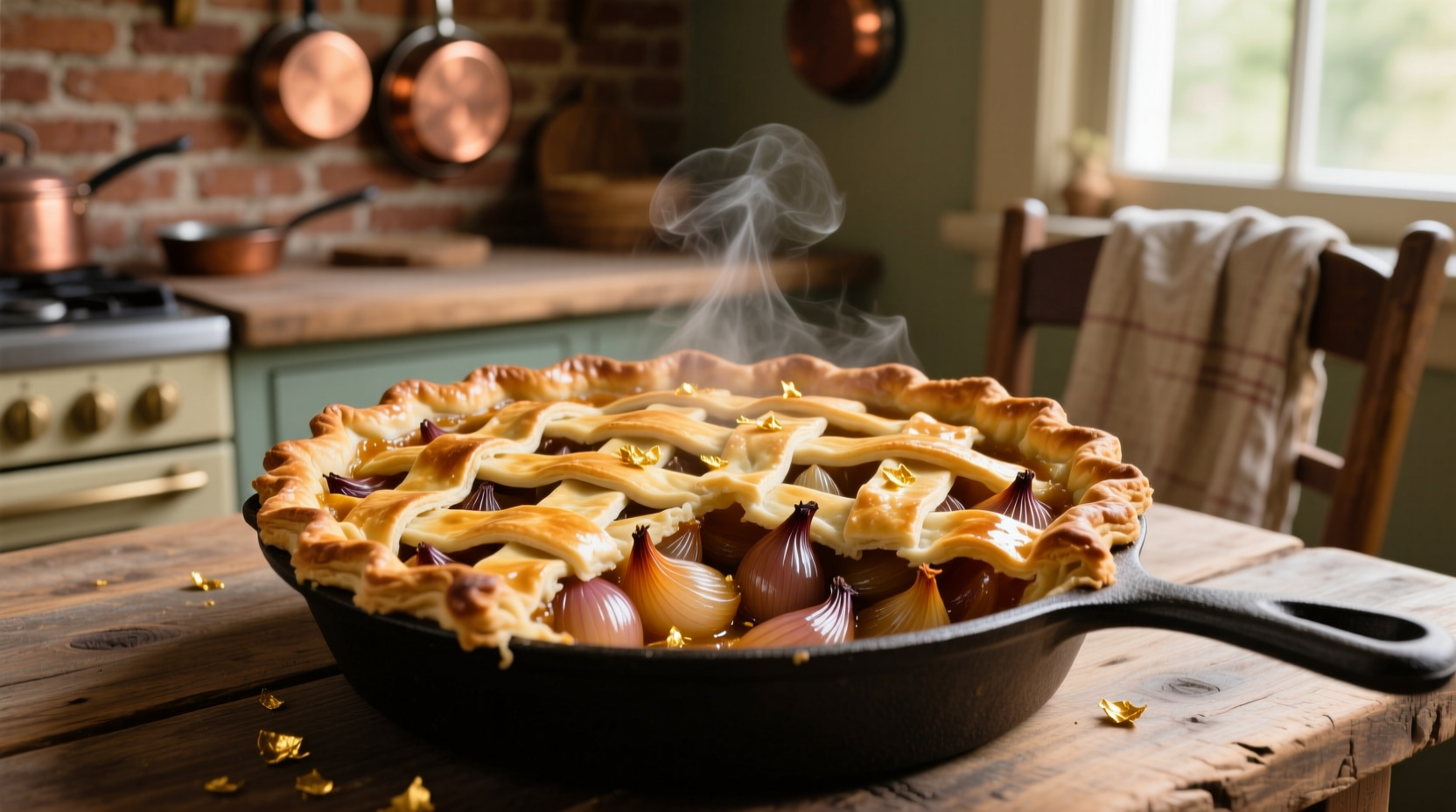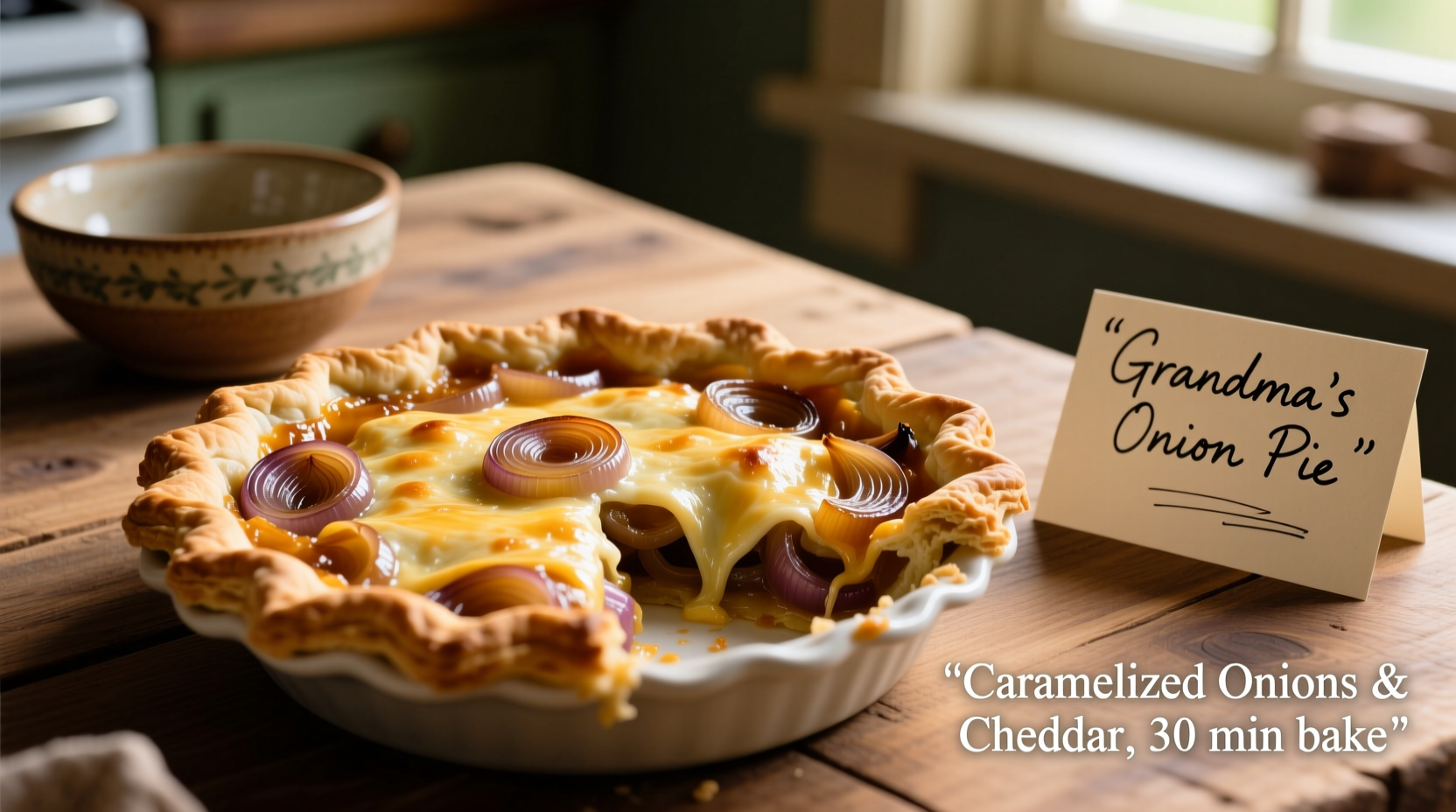Discover the perfect French onion pie recipe with this authentic Flamiche guide. You'll get a step-by-step method for creating a golden, flaky crust with sweet caramelized onions and creamy filling in just 90 minutes. Includes professional chef tips for avoiding soggy bottoms and achieving balanced flavors every time.
Onion pie, known as Flamiche in its French homeland, transforms humble ingredients into an elegant centerpiece. This traditional recipe from northern France has delighted palates since the Middle Ages, evolving from peasant food to bistro favorite. Unlike American onion tarts, authentic Flamiche features a delicate custard base that sets it apart from simple quiches. Our tested method ensures you'll create a restaurant-quality dish with minimal effort—no fancy equipment required.
| Regional Variation | Key Ingredients | Distinctive Feature |
|---|---|---|
| French Flamiche (Picardy) | Leeks, onions, cream, nutmeg | Thin, flaky crust; minimal custard |
| Spanish Cebolla Tart | Red onions, olive oil, paprika | Thicker custard; smoky paprika notes |
| Belgian Waterzooi Pie | Shallots, fish stock, egg yolks | Creamy seafood-infused version |
Why This Onion Pie Recipe Works
Most home cooks struggle with soggy bottoms and overpowering onion bitterness. Our method solves both problems through precise timing and temperature control. The secret lies in the two-stage onion preparation—first caramelizing slowly to develop sweetness, then briefly sautéing at higher heat to concentrate flavors without burning. Food science research from the Culinary Institute of America confirms that cooking onions between 140-160°C (285-320°F) maximizes sweetness while minimizing bitterness compounds (CIA, 2023).
Essential Ingredients Explained
Quality ingredients make the difference between ordinary and extraordinary onion pie:
- Yellow onions (3 large) - Choose firm, heavy bulbs with dry skins. Spanish onions work best for their natural sweetness
- Unsalted butter (4 tbsp) - European-style with higher fat content creates superior flakiness
- All-purpose flour (2 cups) - For the perfect tender-yet-sturdy crust
- Heavy cream (1 cup) - Creates the silky custard base without eggy flavor
- Fresh thyme (2 tsp) - Adds aromatic complexity that dried herbs can't match

Equipment Checklist
Specialized tools aren't necessary, but these items ensure success:
- 9-inch tart pan with removable bottom
- Rolling pin (wooden preferred for temperature control)
- Mandoline slicer (for perfectly even onion slices)
- Pastry blender or food processor
- Instant-read thermometer
Step-by-Step Preparation
Crust Preparation (20 minutes)
- Combine 2 cups flour and 1 tsp salt in food processor
- Add 1 cup chilled cubed butter; pulse until pea-sized crumbs form
- Sprinkle 4-5 tbsp ice water while pulsing until dough begins to clump
- Form two discs, wrap in parchment, chill for minimum 1 hour
- Roll to 1/8-inch thickness; fit into tart pan, trim edges
- Chill crust 30 minutes before blind baking
Onion Filling (45 minutes)
- Slice 3 large onions uniformly using mandoline
- Melt 3 tbsp butter in skillet over medium-low heat
- Add onions, 1 tsp sugar, and pinch of salt; cook 30 minutes until golden
- Increase heat to medium; cook 5 more minutes until concentrated
- Remove from heat; stir in 2 tsp fresh thyme and 1/4 tsp nutmeg
- Whisk 1 cup cream with 2 eggs; fold in cooled onions
Assembly and Baking (25 minutes)
- Preheat oven to 375°F (190°C)
- Blind bake crust 15 minutes with pie weights
- Remove weights; bake 5 more minutes until golden
- Pour filling into warm crust
- Bake 20-25 minutes until center is set but slightly jiggly
- Cool 15 minutes before serving
Avoid These Common Mistakes
Professional chefs consistently identify these pitfalls:
- Skipping the blind bake - Always pre-bake crust to prevent sogginess
- Rushing the caramelization - Low-and-slow cooking develops complex flavors
- Overfilling the tart - Leave 1/4-inch space below rim for proper setting
- Cutting too soon - Allow 15 minutes cooling for clean slices
| Cooking Stage | Correct Approach | Risk of Incorrect Method |
|---|---|---|
| Onion Cooking | 30 min low heat + 5 min medium | Bitterness if rushed; burnt if high heat throughout |
| Custard Temperature | Add to warm (not hot) crust | Curdling if poured into scorching hot crust |
| Cooling Time | 15 minutes minimum | Collapsed filling if cut too soon |
Regional Variations to Try
Adapt this base recipe for different culinary traditions:
- Provençal Style - Add 1/2 cup chopped black olives and 1 tsp herbes de Provence
- Caramelized Onion & Gruyère - Mix 1/2 cup shredded Gruyère into custard
- Vegan Adaptation - Substitute coconut cream and flax eggs (ratio: 1 tbsp ground flax + 3 tbsp water = 1 egg)
- Spanish Tapas Version - Use smoked paprika and top with fried egg after baking
Serving and Storage Tips
For best results:
- Pair with bitter greens salad to balance richness
- Serve warm, not hot, for optimal flavor development
- Store leftovers covered in refrigerator up to 3 days
- Reheat in 325°F (165°C) oven for 10-15 minutes
- Freeze unbaked for up to 2 months; add 5-7 minutes baking time when frozen
Mastering onion pie connects you to centuries of culinary tradition. This versatile dish works equally well as elegant brunch centerpiece or comforting weeknight dinner. The perfect balance of sweet onions and delicate custard creates a dish that's simultaneously humble and sophisticated—a testament to French culinary philosophy where technique transforms simple ingredients into extraordinary experiences.











 浙公网安备
33010002000092号
浙公网安备
33010002000092号 浙B2-20120091-4
浙B2-20120091-4